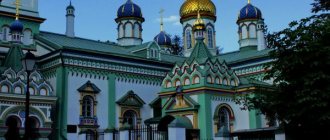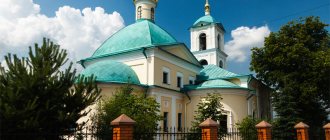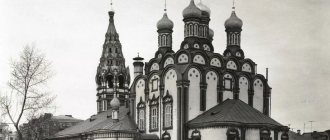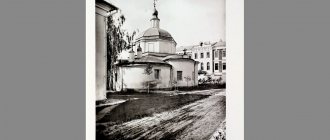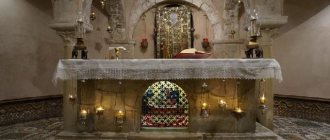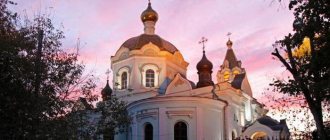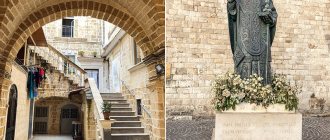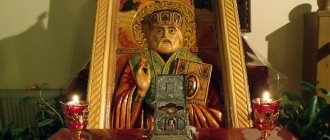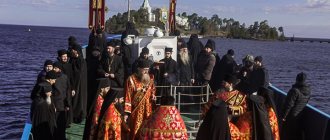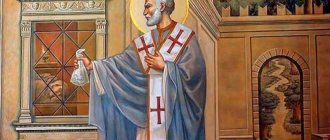| Moscow St. Nicholas Church in Klenniki, 2006. Photo by Mikhail Chuprinin from the site sobory.ru |
Moscow Church in the name of St. Nicholas the Wonderworker in Klenniki, Blinniki, Maroseyka
- Thrones: St. Nicholas the Wonderworker (main); Kazan Icon of the Mother of God; All the saints who shone in the Russian land; Alexy, Elder of Moscow (Mechev) and sschmch. Sergius.
- Address: Russia, Moscow, st. Maroseyka, 5. M. Kitay-Gorod
- Official site:
- On the map: Yandex.Map, Google map
On this site was the Church of Simeon Divnogorets, built according to the vow of John III in 1468 in one day, in gratitude that the severe fire of Moscow did not spread to the Kremlin.
This church was mentioned in 1625. The current church was built in 1657 close to the Church of Simeon Divnogorets, which explains the fracture of the wall of the northern aisle. The church was rebuilt several times.
In the 17th century, the church was called the Church of St. Nicholas “in Blinniki” (Sytin mentions that they actually sold pancakes here), but in the 18th century “Blinniki” somehow transformed into “Klenniki”. There is an assumption that this is connected with the appearance of the icon of St. Nicholas in the village of Klenniki near Moscow. In metric 1886-87. O.
The church was significantly rebuilt after the fire of 1701: the upper part of the quadrangle was dismantled, and the lower part was turned into a basement, above which a new, double-height volume with an apse and a vestibule was erected, which acquired the features of the “Naryshkin style.”
After the fire of 1748, the church was significantly updated, and a bell tower was erected in 1749. Other renovations of the church are mentioned in 1853, 1868, 1894. The main Kazan throne was built on the second floor.
In the 1920s, the external decor, lost during the reconstruction of the 18th-19th centuries, was restored. At the end of the 1920s, the chapel of Alexy, the man of God, was built in the temple.
In 1932 the temple was closed. The last Divine Liturgy was celebrated on the Annunciation. After her, the only priest of the temple remaining at large by that time was arrested. On October 6, the temple was finally closed and destroyed.
| Church of St. Nicholas in Klenniki, 1970s |
The chapter was demolished from the bell tower, and the chapter along with the octagonal drum from the quadrangle, so that it simply ended with a hipped roof.
The church building was used after internal redevelopment as a utility room for neighboring institutions - the Central Committee of the Komsomol was located in house No. 3, which located its accounting department here. The altar part was used as a cash register. In the quadrangle, at the level of the high windows, the upper floor was built. All church decoration and wall paintings were destroyed with great care, with the only exception being the painting of the inaccessibly high ceiling of the Kazan chapel quadrangle.. Part of the church building was rebuilt for housing. The building was under state protection. After the temple was returned to believers on July 18, 1990, the destroyed domes were restored.
History of the appearance of the temple
The building book of 1657 describes the ancient monastery as the Church of St. Nicholas the Wonderworker, located on the Intercession. About the Church of the Intercession of the Virgin Mary in 1698 it was written that it is a chapel of this temple complex and is located in Blinniki; in 1701 it is reported that this is already Klinniki or Klenniki.
Church of St. Nicholas the Wonderworker in Klenniki, Moscow
According to the description of Sigismund Krzhizhanovsky, made in 1625, we find an explanation for such marvelous names of this area. When maples grew around the church, sandwiched by tall buildings, the area was called Klenniki.
The trees were cut down, but a blade maker appeared in this area, and the name Klinniki appeared, the area began to attract citizens with delicious pancakes, here you have Blinniki. By the 15th century, Moscow was a small fortification of Borovitsky Hill, around which villages and settlements were molded.
During the reign of the Grand Duke of All Rus' Ivan the Third, the Kuznetskaya Sloboda with the Cannon Yard appeared, the Chrysostom Monastery was erected, and new holy monasteries appeared among the grand ducal gardens and estates. The local population calls the street starting from the Ilyinsky Gate Pokrovka, after the name of the nearby Church of the Intercession of the Virgin, and the houses nearby to the Kremlin were called Maloroseyka or Maroseyka.
The historical reference by Pyotr Sytin indicates that in 1468, by order of Ivan the Third, a chapel was built in honor of Simeon Divnogorets, as a token of gratitude to God for saving the Kremlin from the fire that raged in the White City.
In the Scribe Book of 1620 there is already mention of a wooden temple building in Blinniki, near which a stone church was built in 1657. Records from 1690 mention the chapels of the Kazan Mother of God and St. Nicholas in Blinniki.
Interesting! After the fire of 1701, a new chapel of the Kazan Icon of the Virgin Mary was erected on the site of the burnt church building, and later a second tier and the Church of St. Nicholas the Wonderworker appeared.
After the fire of 1748, the ancient shrine was again reborn from the ashes; a bell tower and a refectory appeared in its complex.
In 1910, the Church of St. Nicholas the Wonderworker in Klenniki was under the protection of priest Alexy Mechev, who in 2000 was canonized as a saint of the Russian Orthodox Church. You can venerate the holy relics of the elder during the day; they are kept in the lower temple.
At the beginning of the 20th century, a parish school began working; a group of icon painters, led by Maria Sokolova, constantly worked in the ancient monastery.
Fragments of painting the walls of the Church of St. Nicholas
Frequent repairs and renovations led to the fact that the original face of the church was lost; restorer Dmitry Sukhov undertook to restore it in 1927, updating not only the platbands, but also the lower chapel of Alexy the Man of God.
1931 - the time of the closure of the spiritual shrine by the Bolsheviks, its priests were arrested, among them the son of Alexy Mechev, Sergius, who was shot in 1942. The authorities set up offices for the Komsomol central committee in the church building.
Social work, everyday life
The parishioners and the rector carry out feasible social activities. Educational and missionary services are actively developing. Parishioners provide spiritual assistance, care for the sick, located next door to the Clinical City Hospital No. 15 named after. O. Filatova. Priests do not refuse confession, communion, or unction to hospital patients.
Fathers visit not only simple hospital wards, but also those who are in the palliative department. A parishioner of the temple, artist M. Myshkovskaya, creates mosaic icons for Russian churches free of charge. She has already completed more than 30 similar works. Several of her icons are located within the walls of the temple. Young parishioners perform concerts and performances in nursing homes.
Renaissance period
The Church of St. Nicholas the Wonderworker in Klenniki owes its magnificent icons, wall and ceiling paintings to the work of the icon painting school opened at the church.
In mid-July in 1990, the return of the Church of St. Nicholas in Klenniki to Russian Orthodoxy, Father Alexander (Kulikov) was appointed rector of the church.
Since December 17, 1990, after the consecration and restoration of the interior decoration and crosses on the heads of the Russian shrine, services have been held regularly.
Divine service in St. Nicholas Church
Since 2011, Nikolai Vazhnov has been appointed rector of the Church of St. Nicholas.
Clergy, mentors
The rector of the temple is priest Viktor Malshakov. Priest was born in 1974. He graduated from the State Conservatory. A. Nezhdanova with a degree in Choral Conducting and the Odessa Theological Seminary. In parallel with his studies, he worked as a regent and reader in the churches of his native city.
In 2001, he entered the full-time department of the Moscow Theological Academy. In July 2005, after graduation, he was ordained to the rank of deacon, and a month later to the rank of priest. Before becoming a clergyman in Veshnyaki, Father Victor served in such parishes as the Elias Church in Cherkizovo and the Church of the Holy Great Martyr Demetrius of Thessalonica in the village of Vostochny. For excellent services he was awarded a gaiter and a pectoral gold cross.
Current state
The uniqueness of the monastery of the Holy Pleasant is its “squeezing” by city walls. Without peering at the facades of the houses, you can walk past the temple building without noticing it. The architecture of Maroseyka's houses dates back to different times; the absence of a fence and the entrance directly from the street are the distinctive features of the St. Nicholas Church in Klenniki.
The harmony and proportionality of the outline of the quadrangle and the bell tower building in a series of city facades is undeniable.
Interesting! The red color of the building with snow-white frames of windows, doors, and arches gives the church a special zest and nobility.
Despite the fact that the bell tower was erected 50 years later in the style of classicism, it organically fit into the temple complex without violating the Naryshkin style of architecture.
Shrines
For Orthodox believers, nothing has changed since the beginning of the 20th century in terms of spiritual help, when Muscovites came from all parts of the capital for help and advice from the holy righteous Alexy, presbyter of Moscow, and the flow of pilgrims to the holy relics does not stop now.
Reliquary with the relics of St. Alexis, presbyter of Moscow
The second shrine of the Church of St. Nicholas in Klenniki is the bright image of the Mother of God “Theodorovskaya”.
Orthodox Christians also pray at the holy face of the Hieromartyr Sergius, who died for the Orthodox faith.
Patronal holidays
The temple complex of St. Nicholas consists of four chapels.
- The Church of St. Nicholas the Wonderworker welcomes guests on the patronal feast day on May 22 in memory of the transfer of the holy relics of the Myra saint. December 19 is the memory of the saint’s departure into the world of God.
- The patronal feast of the chapel of All Saints who shone forth in the Russian land is June 30.
- The Church of Saint Alexy and Hieromartyr Sergius honors father and son - June 22 is the day of the repose of Alexy; September 29 - commemoration of the transfer of his holy relics; January 6 is the day of repose of St. Sergius.
- The Kazan church is filled with flowers on June 21, as thanksgiving to God for the appearance of the holy face in Kazan;
The date of November 4 is also celebrated - the date of the deliverance of Moscow from the invasion of the Poles under the patronage of the Mother of God.
Interior decoration
The Temple of Alexy Mechev in Veshnyaki is quite modest inside, ascetic by the standards of the Christian church. After passing through a small porch, a person finds himself in the only church boundary. There are no frescoes on the walls, just simple whitewash. To the left of the lectern there is an eve table. A carved four-row iconostasis rises above the narrow salt. The room is illuminated by narrow elongated window openings.
In the evening, ministers light the round central chandelier and several small side lamps. Through the open Royal Doors you can see a gilded altar with an ornate seven-branched candlestick and a large icon of the Lord Pantocrator. The windows in the chancel are made in the tradition of stained glass technology. The pattern of colored glass, made in the style of the Orthodox tradition, carries deep symbolism.
The image of Christ, shining from the sun's rays falling on it, reminds parishioners that the Lord is the “East of Easts” (unfading). According to Christian tradition, glass also carries a symbol of purity and innocence. Along the perimeter of the middle part of the temple, a second tier is built on the choir choir, where singers are located during services.
Where is it located, what is in the surrounding area, how to get there
The temple is located in the Eastern Administrative District of Moscow at the address: st. Veshnyakovskaya, building No. 16. From the stop complex near the Vykhino metro station, buses No. 232 and No. 247, as well as trolleybuses No. 30 and No. 64, depart towards the temple. Transport reaches the stop "15 city hospital" in about 6 minutes.
Travelers are interested in the Temple of Alexei Mechev in Veshnyaki primarily as an example of modern architecture and religious national culture. Getting to know it is included in the excursion program of most pilgrimage tours in the capital.
Sunday School
There is a Sunday school at the temple. Not only middle-aged students come here, but also children with whom they study according to a separate program. For preschoolers, an introduction to the Law of God is taught in a playful way. In addition to studying, they enjoy drawing and sculpting.
Middle-aged children are introduced to biblical stories in lessons; the structure of the temple and the meaning of Orthodox holidays are explained to them. Teachers tell stories from the Old Testament.
Children enjoy attending hobby groups:
- drawing;
- artistic modeling;
- choral singing.
In addition to lessons together with school teachers, students prepare thematic theatrical performances and concerts for parishioners. A Youth Association has been created for teenagers and students. Participants in the movement help teachers work with children, try their hand as volunteers, and take part in tournaments of the Moscow Orthodox Intellectual Club “What? Where? When?".
The Sunday school director and teachers take an active part in preparing performances, concerts dedicated to Orthodox holidays, and church events.
Every Sunday in the church there are readings and conversations in the Gospel circle. Anyone can come up, listen, and chat with the priest. The work of the circle starts at 15:30.
Service schedule, operating hours
The Temple of Alexy Mechev in Veshnyaki is open daily:
Temple of Alexy in Veshnyaki, contacts and information.
| Day of the week | Time |
| Weekdays | 09:00 — 19:00 |
| Days of worship, holidays | 08:00 — 20:00 |
| On Sundays, the beginning of the Divine Liturgy | 08:30 |
| Great holidays, beginning of the Divine Liturgy | 09:00 |
| On the eve the All-Night Vigil is served, the sacrament of confession is performed | 17:00 |
Accurate information about the times of services on holidays, custom prayers and memorial services can be obtained on the official website in the “Schedule of Services” section, on the website page VKontakte, Facebook.
